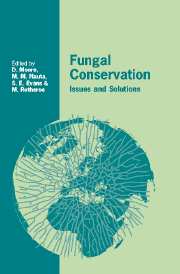Book contents
- Frontmatter
- Contents
- List of contributors
- Preface
- 1 Fungal conservation issues: recognising the problem, finding solutions
- 2 Current trends and perspectives for the global conservation of fungi
- 3 Conservation and management of forest fungi in the Pacific Northwestern United States: an integrated ecosystem approach
- 4 The future of fungi in Europe: threats, conservation and management
- 5 Fungi as indicators of primeval and old-growth forests deserving protection
- 6 Recognising and managing mycologically valuable sites in The Netherlands
- 7 Threats to hypogeous fungi
- 8 Wild mushrooms and rural economies
- 9 Threats to biodiversity caused by traditional mushroom cultivation technology in China
- 10 A preliminary survey of waxcap grassland indicator species in South Wales
- 11 Grasslands in the coastal dunes: the effect of nature management on the mycota
- 12 The conservation of fungi on reserves managed by the Royal Society for the Protection of Birds (RSPB)
- 13 Strategies for conservation of fungi in the Madonie Park, North Sicily
- 14 Fungal conservation in Ukraine
- 15 The threatened and near-threatened Aphyllophorales of Finland
- 16 Fungal conservation in Cuba
- 17 Microfungus diversity and the conservation agenda in Kenya
- 18 Fungi and the UK Biodiversity Action Plan: the process explained
- 19 The Scottish Wild Mushroom Forum
- 20 The contribution of national mycological societies: establishing a British Mycological Society policy
- 21 The contribution of national mycological societies: the Dutch Mycological Society and its Committee for Fungi and Nature Conservation
- 22 Fungal conservation in the 21st century: optimism and pessimism for the future
- Index
4 - The future of fungi in Europe: threats, conservation and management
Published online by Cambridge University Press: 13 October 2009
- Frontmatter
- Contents
- List of contributors
- Preface
- 1 Fungal conservation issues: recognising the problem, finding solutions
- 2 Current trends and perspectives for the global conservation of fungi
- 3 Conservation and management of forest fungi in the Pacific Northwestern United States: an integrated ecosystem approach
- 4 The future of fungi in Europe: threats, conservation and management
- 5 Fungi as indicators of primeval and old-growth forests deserving protection
- 6 Recognising and managing mycologically valuable sites in The Netherlands
- 7 Threats to hypogeous fungi
- 8 Wild mushrooms and rural economies
- 9 Threats to biodiversity caused by traditional mushroom cultivation technology in China
- 10 A preliminary survey of waxcap grassland indicator species in South Wales
- 11 Grasslands in the coastal dunes: the effect of nature management on the mycota
- 12 The conservation of fungi on reserves managed by the Royal Society for the Protection of Birds (RSPB)
- 13 Strategies for conservation of fungi in the Madonie Park, North Sicily
- 14 Fungal conservation in Ukraine
- 15 The threatened and near-threatened Aphyllophorales of Finland
- 16 Fungal conservation in Cuba
- 17 Microfungus diversity and the conservation agenda in Kenya
- 18 Fungi and the UK Biodiversity Action Plan: the process explained
- 19 The Scottish Wild Mushroom Forum
- 20 The contribution of national mycological societies: establishing a British Mycological Society policy
- 21 The contribution of national mycological societies: the Dutch Mycological Society and its Committee for Fungi and Nature Conservation
- 22 Fungal conservation in the 21st century: optimism and pessimism for the future
- Index
Summary
Introduction
During the 9th Congress of European Mycologists in Oslo, 1985, quantitative data were presented for the first time on changes in the mycota, in particular in The Netherlands (Arnolds, 1988). These data supported the fears of many mycologists and naturalists, namely that macrofungi were decreasing, at least some species in some areas. This information was the motive for the establishment of the European Committee for Protection of Fungi, which later changed its name into the European Council for Conservation of Fungi (ECCF). In this chapter I will review the developments in fungus conservation in Europe during the past 15 years and look forward towards challenges in the future. I restrict myself to macrofungi since microfungi are rarely considered in relation to conservation (but see Chapter 17).
Effective conservation of fungi depends on the compilation and integration of data from different disciplines, here summarised in the scheme shown in Fig. 4.1. Central in this scheme are Red Data lists because they reflect our knowledge on the status of fungal species and are meant as a basis for measurements and to present our conclusions to a wider audience. Obviously, progress in conservation depends on progress in other mycological disciplines, such as taxonomy, distribution and ecology. Therefore I shall pay some attention to these disciplines as well.
- Type
- Chapter
- Information
- Fungal ConservationIssues and Solutions, pp. 64 - 80Publisher: Cambridge University PressPrint publication year: 2001
- 16
- Cited by



